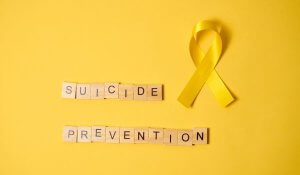 One of my own experiences with encountering suicide was the death of a close family friend at the age of 20. All of his life had been marked by mental health challenges, with the concern that he wouldn’t be long for this world, spoken about in whispers. Since then, I’ve had to deal with other people showing signs of suicidal thoughts for various reasons, such as a cousin led there by substance abuse issues, a friend experiencing the stress of being a parent and sole provider, and a mentor from trauma in an abusive marriage. While some of these cases may not have been preventable, in my opinion, even one death from suicide is too many, and I, for one, no longer speak about it in whispers, as it may do more harm than good.
One of my own experiences with encountering suicide was the death of a close family friend at the age of 20. All of his life had been marked by mental health challenges, with the concern that he wouldn’t be long for this world, spoken about in whispers. Since then, I’ve had to deal with other people showing signs of suicidal thoughts for various reasons, such as a cousin led there by substance abuse issues, a friend experiencing the stress of being a parent and sole provider, and a mentor from trauma in an abusive marriage. While some of these cases may not have been preventable, in my opinion, even one death from suicide is too many, and I, for one, no longer speak about it in whispers, as it may do more harm than good.
The theme for World Suicide Prevention Day in 2025 is Changing the Narrative on Suicide. This theme focuses on raising awareness about the need to reduce the stigma that surrounds suicidal thoughts and promote open discussions to help prevent suicides. It encourages a shift in how people view such thoughts, moving away from silence and judgment toward understanding, support, and compassion.
Suicide is a major public health challenge, with more than 700,000 deaths each year globally. Suicide has a wide impact, affecting people emotionally, socially, and economically. It affects individuals and communities worldwide. World Suicide Prevention Day was created by the International Association for Suicide Prevention along with the World Health Organization (WHO). Every year on September 10, the day focuses on raising awareness among organizations, governments, and the public with a clear message: suicide, in many cases, is preventable.
What can cause someone to become suicidal?
Suicidal behavior is often a sign of deep unhappiness and is not always linked to mental health issues. Many people with mental health challenges are not suicidal, and not everyone who commits suicide has a mental health condition.
In high-income countries, it is well-known that mental health issues like depression, alcohol use disorders, and a history of suicide attempts are linked to suicide. However, many suicides occur suddenly during moments of intense stress or crisis. Other factors that increase the risk of suicide include feelings of loss, loneliness, discrimination, relationship problems, financial struggles, chronic pain or illness, experiences of violence or abuse, and living through conflict or humanitarian emergencies.
What are some of the risk factors for suicide?
Suicide is a complicated issue influenced by many different factors that can cause someone to have suicidal thoughts or behaviors. It is impossible to know for certain who might take their own life, but certain risk factors can increase the likelihood.
- Stressful situations like money problems, the end of a relationship, or losing a loved one
- Health problems or serious illness
- Ongoing mental health struggles like depression
- A history of mental illness or past suicide attempts
- Drug or alcohol misuse
- Living in difficult or unsafe conditions
- Experiencing trauma such as family violence, sexual abuse, or assault.
What are some of the warning signs of suicide? 
It’s not always easy to tell when someone is dealing with suicidal thoughts, but many people show warning signs before attempting suicide. They might talk about feeling hopeless or worthless, lose interest in activities they once enjoyed, or pull away from friends, family, or daily routines. They may seem distant, stop responding to messages or calls, or become easily irritated, exhibiting sudden emotional outbursts. Sometimes, they even make comments or jokes about not wanting to live anymore.
There are times when no signs of suicide are visible. If someone appears troubled, it is essential to check on them, speak with them, and seek guidance from professionals who can offer support.
Stigma around seeking help
Stigma plays a significant role in suicide, creating a cycle where it both affects those with mental illness and contributes to mental health struggles and suicide. Stigma can make individuals feel isolated, lead to alcohol or drug misuse, and stop them from seeking help or treatment. This delay in getting support can increase the chances of suicide.
Even with all the progress in medicine and technology, mental illness and suicide are still difficult and uncomfortable topics in society.
Despite improved training and more resources for health professionals and patients, stigma around mental health and suicide remains a serious issue with harmful effects on individuals and society. A survey of over 500 people dealing with mental health challenges found that 86% avoided activities they wanted to do, including seeking help, because they feared stigma or discrimination.
Building a stigma-free support system
This year’s theme for World Suicide Prevention Day is especially timely. With rising mental health challenges and increasing pressures from the cost of living and societal demands, individuals struggling with suicidal thoughts must have the opportunity to talk with healthcare providers, support organizations, or trusted individuals. These conversations can provide the help, support, and guidance they need.
Reducing stigma is a crucial focus, and it should begin within the medical community. Doctors can take action, both individually and as a group, to remove the harmful stigma connected to mental health issues in their profession.
Are there ways to lower the levels of suicidal thoughts?

Living a healthy lifestyle can play a role in preventing suicide. Improving mental health may include reducing drug and alcohol use, eating nutritious foods, exercising regularly, maintaining a consistent sleep schedule, and cutting back or quitting smoking.
A safety plan can be a helpful tool for someone to manage difficult times or cope with thoughts of suicide.
How can the body and mind be supported during times of high stress?
During periods of high stress or crisis, maintaining both mental and physical well-being can make a significant difference. Simple dietary supplements, such as the Stress Pack and Sleep Pack, are designed to help manage feelings of being overwhelmed by supporting the nervous system, reducing anxiety, and promoting relaxation. The Stress Pack includes ingredients that work together to regulate hormones, improve mood, and restore balance while also aiding focus and energy. The Sleep Pack, on the other hand, is formulated for individuals experiencing sleep disruptions associated with stress or anxiety, utilizing melatonin, magnesium, and a calming herbal blend to promote deep, restful sleep. Together, these packs offer a comprehensive approach to managing stress, improving sleep, and supporting mental health during challenging times.
Questions people ask about suicide prevention
How best to talk to a person who has suicidal thoughts?
It’s important to talk honestly about suicide and not avoid using the word. Show understanding and avoid making the person feel blamed or judged. Take their concerns seriously and listen carefully. The goal is to let them express their feelings openly, which may help them share what is causing their distress.
How to help someone close to you who is depressed?
When someone is feeling upset, it’s important to show that you care and let them know you’re there to listen. Accepting them for who they are without judging them can make a big difference. You can also encourage them to take small steps to feel better, like staying active, eating nutritious food, or spending time on hobbies they enjoy.
What are the main causes of suicidal thoughts?
People who think about suicide are going through deep emotional pain and might see it as a way to make that pain stop. This pain can come from many different situations or experiences in their lives. Difficult events or problems can sometimes lead to suicidal thoughts or even to actions of self-harm.














